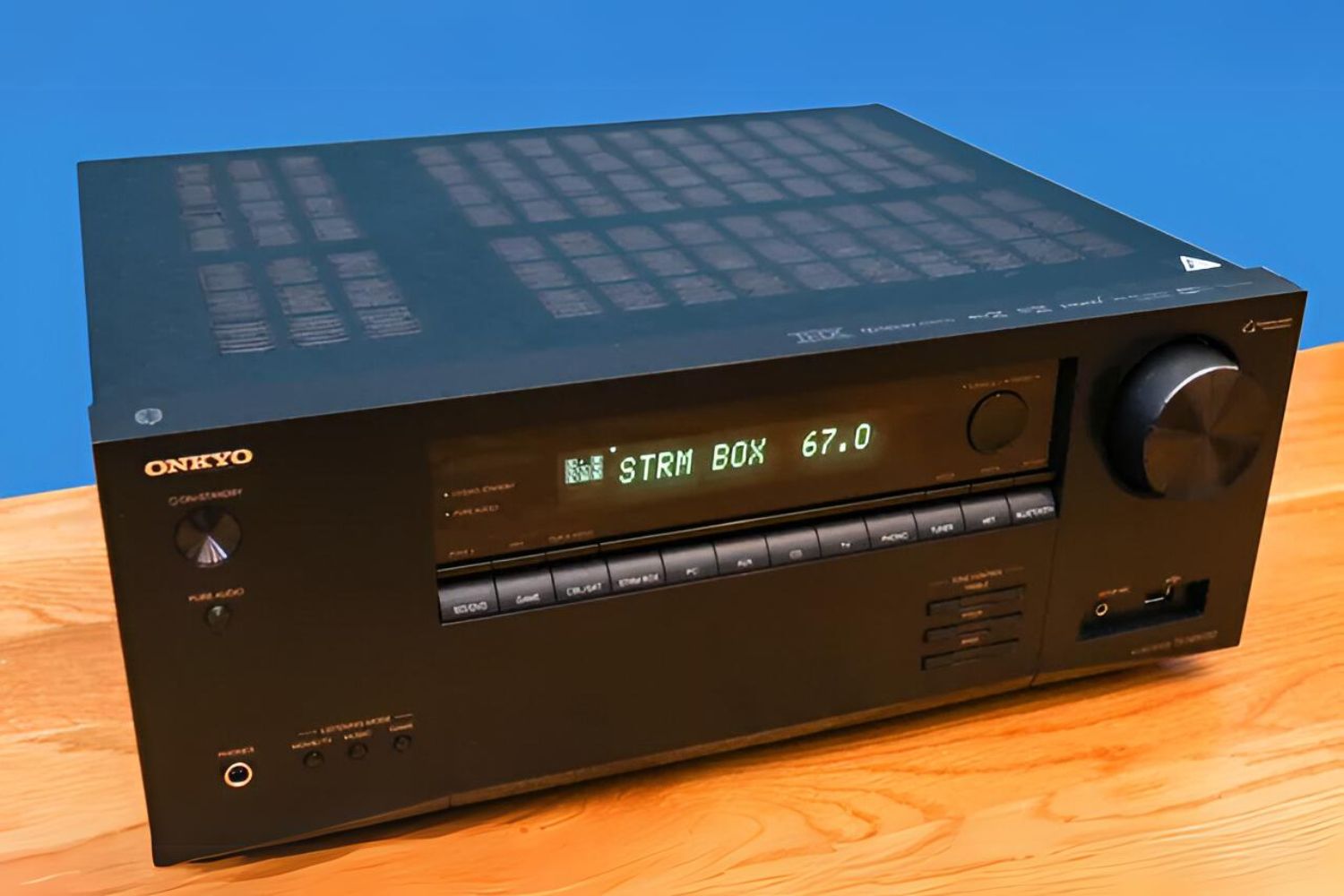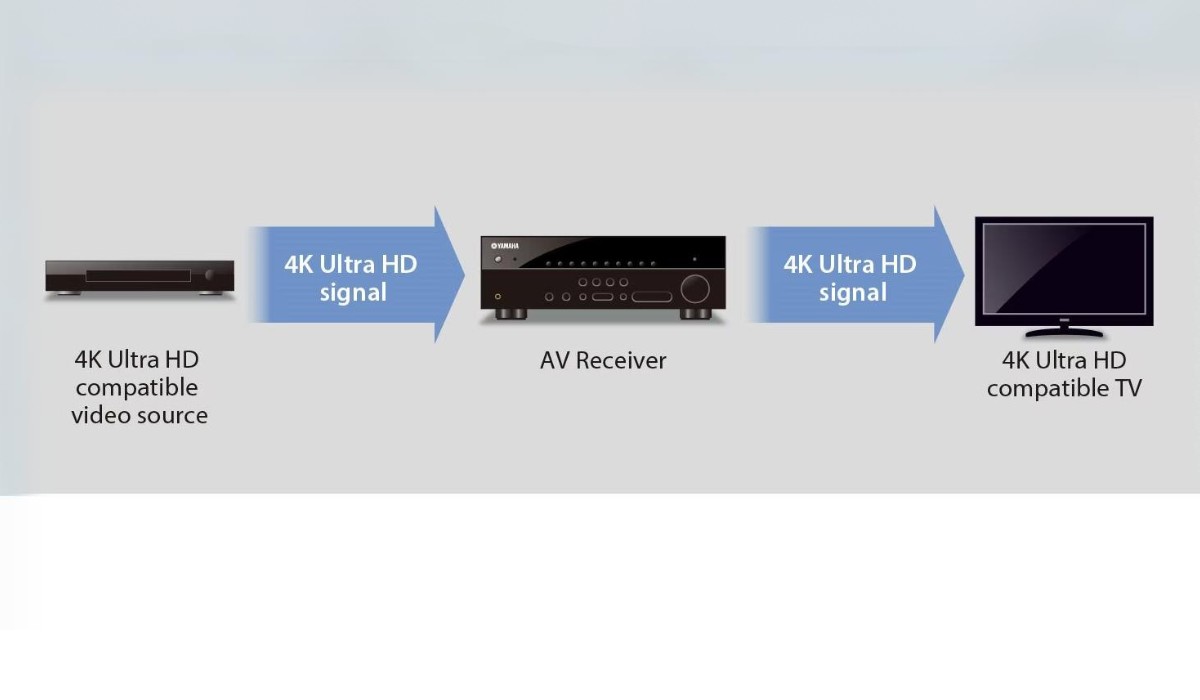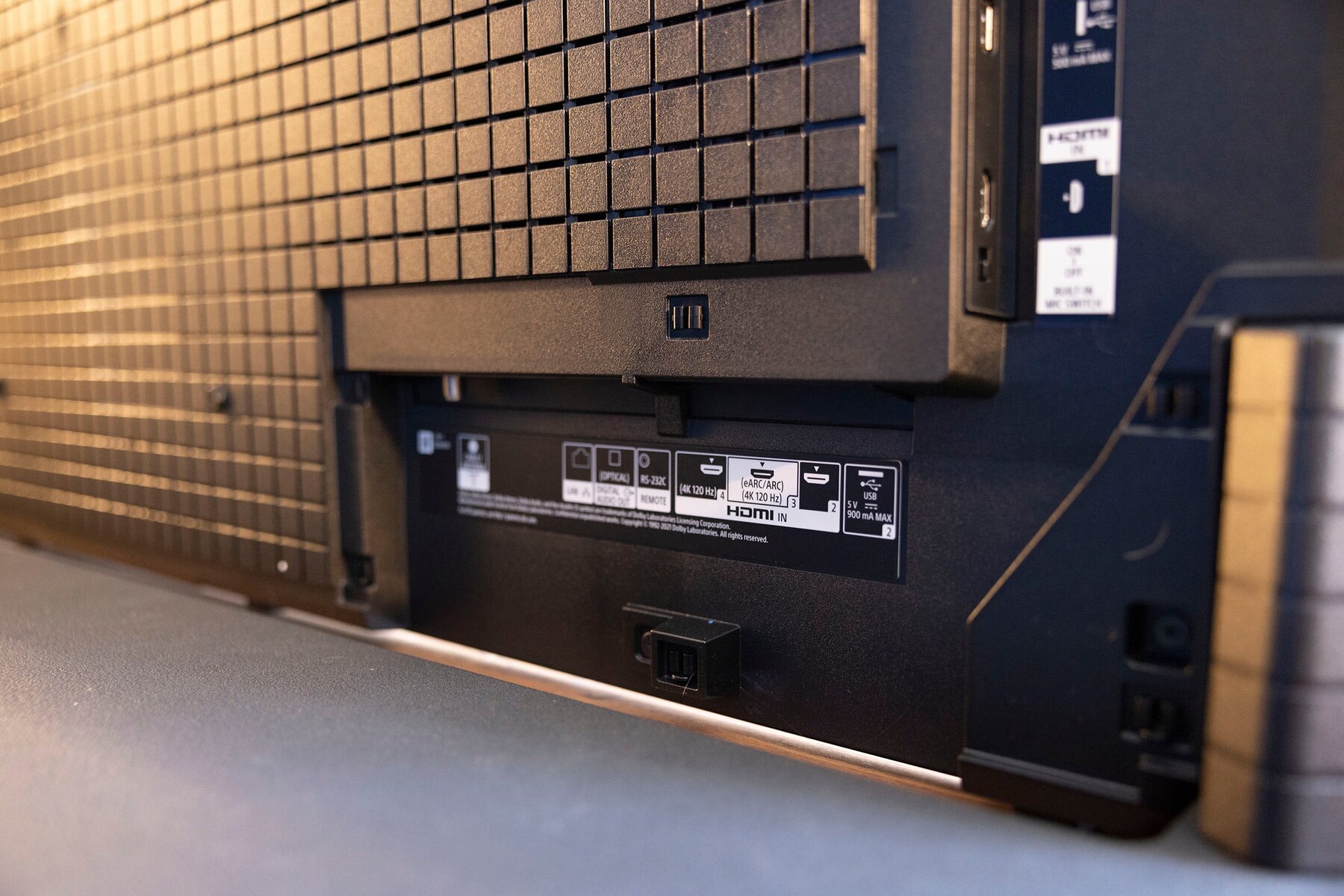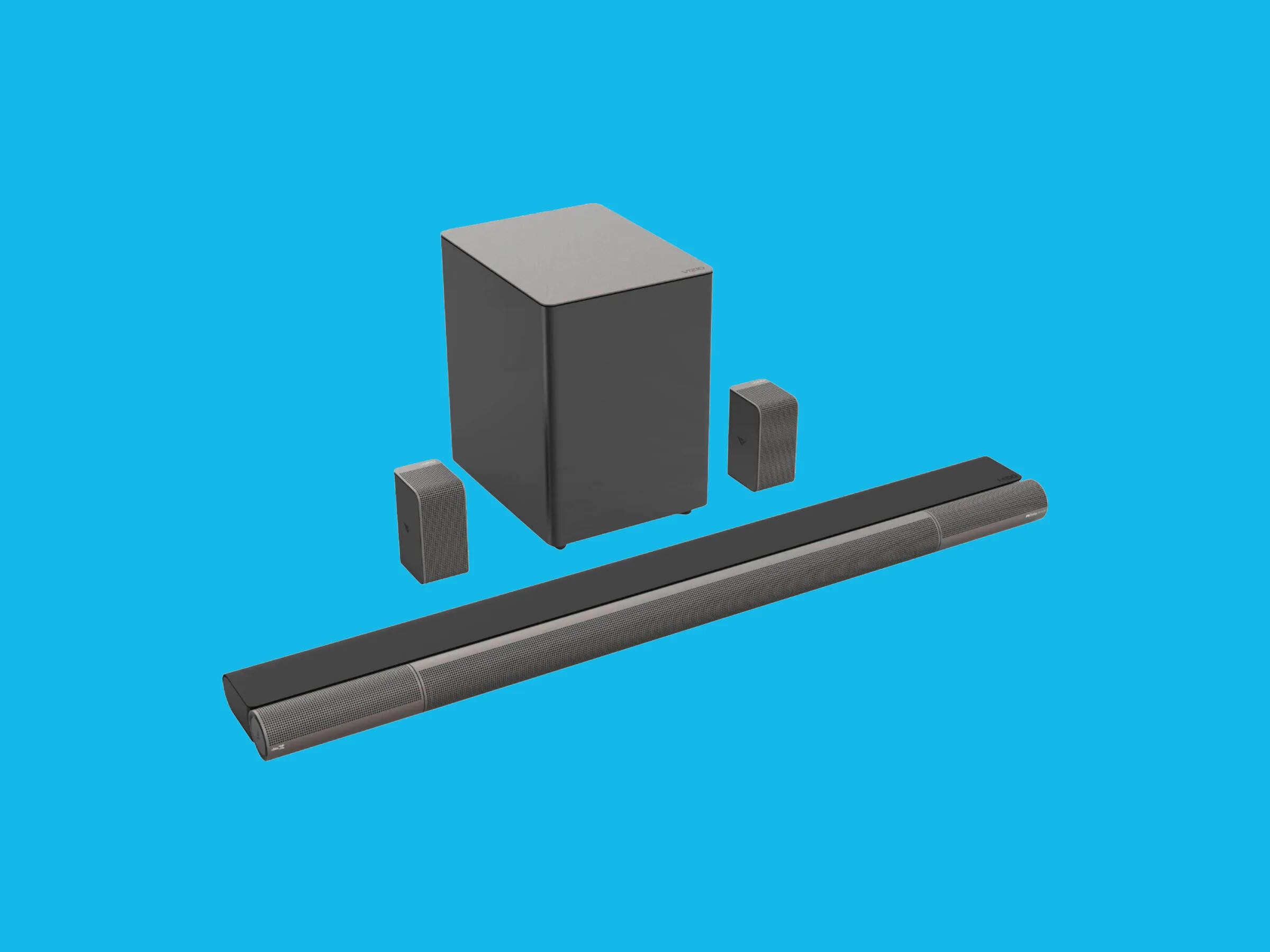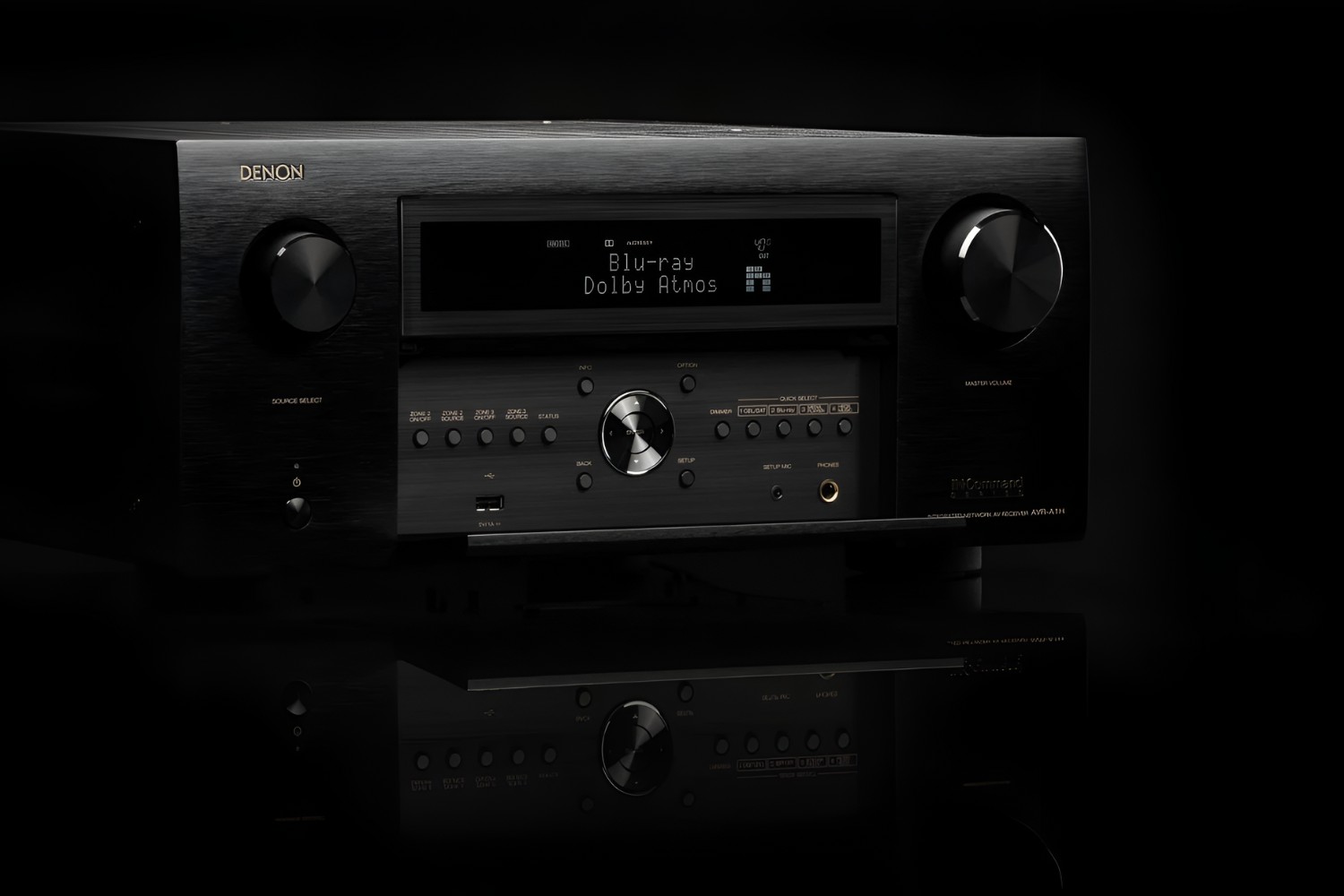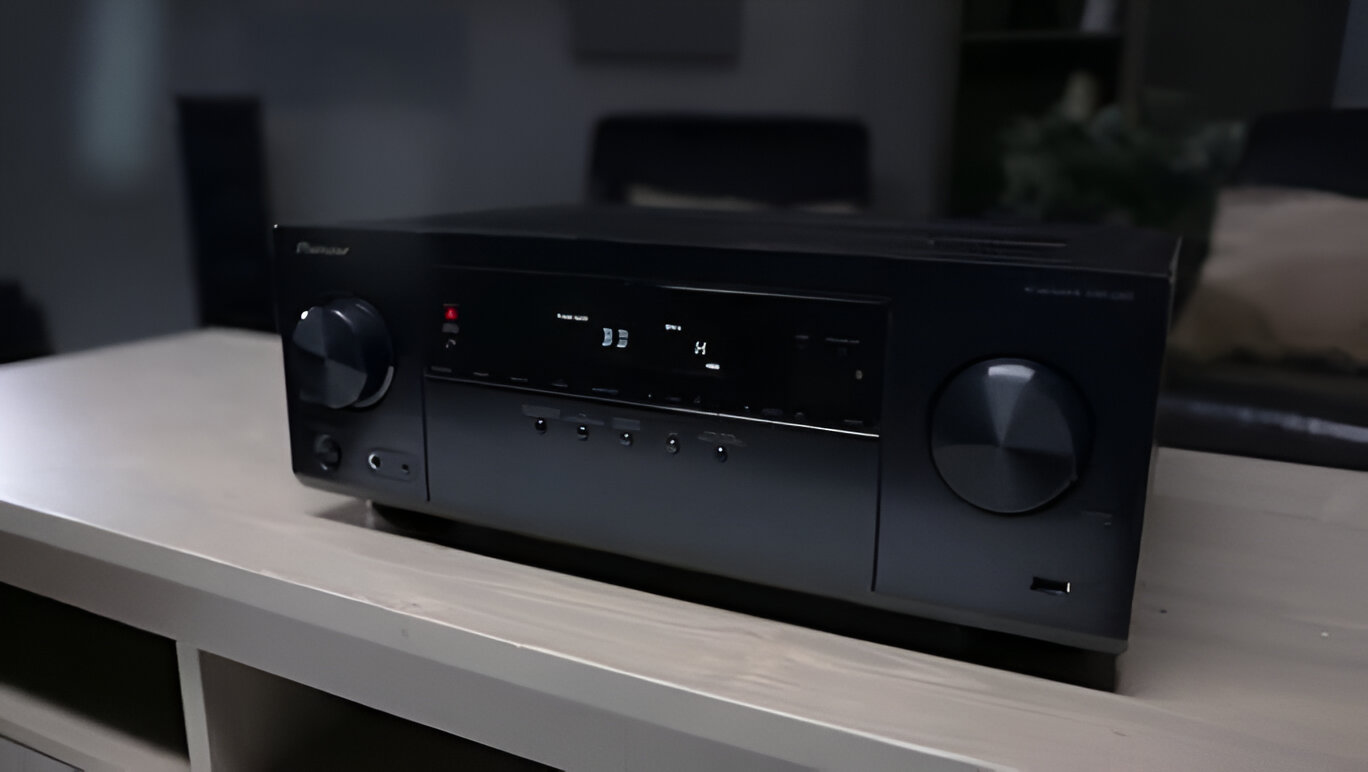Introduction
If you're passionate about high-quality audio and immersive home entertainment experiences, an AV receiver is an indispensable component of your audiovisual setup. This sophisticated device serves as the central nerve center for your entire home theater system, seamlessly integrating various audio and video sources and delivering a captivating, theater-like experience within the confines of your living room. Whether you're a cinephile, a music enthusiast, or a casual viewer seeking to elevate your entertainment setup, understanding the pivotal role of an AV receiver is crucial in crafting a truly immersive and powerful home theater experience.
At its core, an AV receiver functions as a versatile and powerful amplifier that drives the audio output of your speakers, ensuring crystal-clear sound reproduction across a wide range of frequencies. However, its capabilities extend far beyond amplification, as it serves as a multi-faceted hub that consolidates audio and video signals from diverse sources, such as Blu-ray players, gaming consoles, streaming devices, and cable boxes. This convergence of functionalities makes the AV receiver an indispensable cornerstone of any modern home entertainment system, offering a seamless and feature-rich platform for enjoying a diverse array of media content.
In the subsequent sections, we will delve into the multifaceted capabilities of an AV receiver, exploring its pivotal role as a central audio and video hub, its formidable power and performance attributes, its extensive connectivity options, its prowess in delivering immersive surround sound experiences, its advanced room calibration and optimization features, its user-friendly interface, and its ability to future-proof your entertainment setup. By the end of this exploration, you will gain a comprehensive understanding of why an AV receiver is an indispensable asset for any avid audio and video enthusiast seeking to elevate their home entertainment experience.
What is an AV Receiver?
An AV (audio-video) receiver is a sophisticated and multifaceted electronic component that serves as the heart of a home theater or audiovisual system. It combines the functionality of a stereo amplifier with advanced audio and video processing capabilities, making it a pivotal component for anyone seeking a high-quality and immersive entertainment experience. At its core, an AV receiver functions as a central hub that consolidates audio and video signals from various sources, processes them, and distributes them to connected speakers and display devices.
One of the defining features of an AV receiver is its ability to amplify audio signals and drive multiple speakers, providing a powerful and immersive sound experience. It typically includes built-in amplifiers that can deliver robust and high-fidelity audio output to create a captivating listening environment. Additionally, modern AV receivers often incorporate advanced audio processing technologies, such as Dolby Atmos, DTS:X, and other proprietary sound formats, enabling them to decode and reproduce multi-channel audio with exceptional precision and spatial accuracy.
On the video front, an AV receiver acts as a central switcher and processor for video signals, allowing users to connect multiple video sources, such as Blu-ray players, gaming consoles, media players, and set-top boxes, and route the signals to a compatible display device, such as a television or a projector. This integration of video processing capabilities ensures seamless and high-quality video playback, making the AV receiver an indispensable component for creating a comprehensive home entertainment system.
Furthermore, AV receivers often feature an array of input and output options, including HDMI, optical, and coaxial connections, facilitating the integration of diverse audio and video sources into a unified system. Some models also support wireless connectivity, enabling seamless streaming from compatible mobile devices and network servers. The versatility and flexibility offered by these connectivity options make the AV receiver a central and adaptable component in modern home entertainment setups.
Central Hub for Audio and Video
An AV receiver serves as the central hub for managing and processing audio and video signals from various sources, making it an indispensable component of any home entertainment system. By consolidating multiple audio and video inputs, such as Blu-ray players, gaming consoles, streaming devices, and cable or satellite boxes, an AV receiver streamlines the connectivity and distribution of media content, providing users with a seamless and integrated entertainment experience.
From an audio standpoint, the AV receiver acts as a powerful and versatile amplifier, driving multiple speakers to create a captivating and immersive sound environment. Whether it’s a thrilling movie soundtrack, a concert recording, or a high-energy gaming session, the AV receiver’s amplification capabilities ensure that the audio output is delivered with clarity, precision, and impactful dynamics. Additionally, the receiver’s audio processing features, including support for advanced surround sound formats and room calibration technologies, contribute to an enveloping and realistic audio experience that enhances the enjoyment of movies, music, and games.
On the video front, the AV receiver functions as a central switcher and processor for video signals, enabling users to connect and manage multiple video sources and route them to a compatible display device, such as a television or a projector. This capability eliminates the need for manual cable swapping and simplifies the process of accessing different video sources, enhancing the overall convenience and user experience. Furthermore, the receiver’s video processing features, including support for high-definition and 4K video formats, contribute to delivering stunning visual quality and seamless video playback.
Moreover, the AV receiver’s role as a central hub extends to its ability to decode and process audio and video signals from various sources, ensuring compatibility with a wide range of media formats and devices. This versatility allows users to enjoy a diverse array of content without being limited by connectivity or format constraints, providing a truly integrated and flexible entertainment solution.
Overall, the AV receiver’s function as a central hub for audio and video signals underscores its pivotal role in creating a cohesive and immersive home entertainment experience. By seamlessly integrating diverse media sources and delivering high-quality audio and video output, the AV receiver elevates the enjoyment of movies, music, games, and other forms of media content, making it an essential component for any audiovisual enthusiast.
Power and Performance
One of the defining attributes of an AV receiver is its formidable power and performance capabilities, which are instrumental in delivering a captivating and immersive audiovisual experience. The receiver’s built-in amplifiers play a crucial role in driving speakers and reproducing audio content with clarity, precision, and impactful dynamics. Whether it’s the thunderous explosions in an action movie, the subtle nuances of a musical performance, or the immersive soundscapes of a video game, the AV receiver’s amplification prowess ensures that the audio output is faithful to the original content and capable of enveloping the listener in a rich and engaging sonic environment.
Modern AV receivers are engineered to deliver robust and high-fidelity audio output, catering to the demands of discerning audiophiles and home theater enthusiasts. With ample power reserves and sophisticated circuitry, these receivers can effortlessly drive a variety of speaker configurations, from compact bookshelf speakers to expansive floor-standing models, ensuring consistent and authoritative sound reproduction across the entire frequency spectrum. This capability is particularly crucial for creating a dynamic and immersive listening experience, where the nuances of sound effects, musical instruments, and vocal performances are faithfully rendered with exceptional clarity and realism.
Furthermore, the AV receiver’s performance extends beyond mere amplification, encompassing advanced audio processing technologies that enhance the spatial and immersive qualities of the sound. Support for multi-channel audio formats, such as Dolby Atmos and DTS:X, enables the receiver to decode and reproduce three-dimensional soundscapes, creating a sense of height, depth, and dimensionality that elevates the realism and impact of the audio experience. Whether it’s the sensation of overhead effects in a movie soundtrack or the enveloping ambiance of a concert recording, these advanced audio processing capabilities contribute to a truly captivating and lifelike sonic presentation.
From a video perspective, the AV receiver’s performance attributes include support for high-definition and 4K video formats, ensuring that the visual quality of the content remains uncompromised as it is transmitted to the display device. This capability is crucial for delivering stunning and immersive visual experiences, whether it’s the intricate details of a high-definition movie or the breathtaking clarity of a 4K Ultra HD presentation.
In essence, the power and performance of an AV receiver are foundational to its ability to deliver a compelling and immersive audiovisual experience. By combining robust amplification capabilities with advanced audio and video processing technologies, the receiver ensures that users can enjoy a captivating and lifelike entertainment experience that transcends the limitations of traditional audio and video systems.
Connectivity Options
An AV receiver offers a diverse array of connectivity options, empowering users to seamlessly integrate and manage a wide range of audio and video sources within their home entertainment system. These connectivity features play a pivotal role in simplifying the setup process, enhancing the flexibility of the system, and ensuring compatibility with various media devices, thereby enriching the overall user experience.
One of the primary connectivity options offered by AV receivers is the HDMI (High-Definition Multimedia Interface) input and output ports. HDMI serves as a versatile and high-bandwidth interface for transmitting both audio and video signals, making it an essential conduit for connecting Blu-ray players, gaming consoles, media streaming devices, and cable or satellite boxes to the receiver. The HDMI interface supports high-definition and 4K video formats, ensuring that the visual quality of the content is preserved as it is transmitted from the source device to the receiver and ultimately to the display device.
Additionally, AV receivers often feature a range of analog and digital audio inputs and outputs, including optical and coaxial digital audio connections, as well as RCA and balanced XLR analog inputs. These versatile audio interfaces accommodate a variety of audio sources, such as CD players, turntables, digital audio players, and other analog or digital audio devices, enabling users to integrate diverse audio components into their home entertainment system seamlessly.
Furthermore, many modern AV receivers incorporate networking capabilities, such as built-in Wi-Fi and Ethernet connectivity, allowing users to stream audio and video content from online services, local network servers, and mobile devices. This network connectivity not only expands the range of available media sources but also facilitates firmware updates, remote control functionality, and integration with smart home automation systems, enhancing the overall versatility and functionality of the receiver.
Wireless connectivity options, including Bluetooth and AirPlay, are also prevalent in AV receivers, enabling users to stream audio content from compatible mobile devices, such as smartphones and tablets, directly to the receiver. This wireless capability enhances the convenience and accessibility of the home entertainment system, allowing users to enjoy their favorite music and podcasts with minimal setup and hassle.
Overall, the diverse connectivity options offered by AV receivers underscore their adaptability and versatility as central components of a modern home entertainment system. By providing a comprehensive range of input and output interfaces, including HDMI, analog and digital audio connections, networking capabilities, and wireless streaming options, AV receivers empower users to create a cohesive and integrated audiovisual environment that caters to their diverse media needs.
Surround Sound Processing
The hallmark feature of an AV receiver is its ability to deliver immersive and enveloping surround sound experiences through advanced audio processing technologies. By decoding and reproducing multi-channel audio formats, the receiver creates a three-dimensional sonic environment that enhances the realism and impact of movies, music, and games, elevating the overall entertainment experience for users.
One of the primary surround sound formats supported by modern AV receivers is Dolby Atmos, a revolutionary audio technology that introduces height channels to traditional surround sound setups. By incorporating overhead speakers or utilizing upward-firing speakers, Dolby Atmos-enabled receivers can create a sense of height and dimensionality within the audio field, allowing sound to move around and above the listener, resulting in a more lifelike and immersive audio experience. Whether it’s the sensation of rain falling from above or the rumble of thunder reverberating overhead, Dolby Atmos adds a new dimension to audio playback, enhancing the emotional impact and realism of the content.
In addition to Dolby Atmos, AV receivers often support other advanced surround sound formats, such as DTS:X and Auro-3D, providing users with a diverse range of options for creating captivating audio environments. These formats leverage object-based audio processing techniques to spatially position and move sound elements within the listening space, enabling a more dynamic and realistic portrayal of audio content. Whether it’s the precise localization of sound effects in a movie or the seamless movement of musical instruments in a concert recording, these advanced surround sound processing capabilities contribute to a heightened sense of immersion and engagement.
Furthermore, AV receivers often incorporate proprietary sound processing technologies and sound modes designed to optimize the audio playback for specific content types, room acoustics, and speaker configurations. These features may include virtual surround processing, dialogue enhancement, soundfield adjustments, and room correction algorithms, allowing users to tailor the audio presentation to their preferences and the characteristics of their listening environment. This flexibility and customization options further enhance the versatility and performance of the AV receiver, ensuring that users can enjoy an optimized audio experience that suits their individual preferences and requirements.
Overall, the surround sound processing capabilities of AV receivers play a pivotal role in creating captivating and immersive audio environments that elevate the enjoyment of movies, music, and games. By supporting advanced surround sound formats, proprietary sound processing technologies, and customizable sound modes, the receiver ensures that users can experience audio content with exceptional realism, impact, and spatial immersion, transcending the limitations of traditional stereo playback systems.
Room Calibration and Optimization
Modern AV receivers are equipped with advanced room calibration and optimization technologies that enable users to tailor the audio performance to the unique acoustics of their listening environment, ensuring an optimal and immersive listening experience. These features address the challenges posed by room acoustics, speaker placement, and other environmental factors, allowing users to achieve a more accurate and balanced audio presentation that maximizes the potential of their audiovisual setup.
One of the key room calibration technologies found in AV receivers is Automatic Speaker Calibration (ASC) or Automatic Room Calibration (ARC), which utilizes built-in microphones and sophisticated signal processing algorithms to analyze the acoustic characteristics of the listening area and the performance of connected speakers. By emitting test tones and measuring their responses within the room, the receiver can automatically adjust speaker levels, delay settings, and frequency responses to compensate for acoustic anomalies and optimize the overall sound reproduction. This automated calibration process ensures that the audio output remains balanced and accurate, regardless of the room’s acoustical idiosyncrasies.
Additionally, many AV receivers feature room equalization technologies, such as Audyssey, Dirac Live, or proprietary calibration systems, which go beyond basic speaker level adjustments to address frequency response irregularities and room resonances. These technologies employ sophisticated digital signal processing techniques to apply corrective filters that mitigate peaks and dips in the frequency response, resulting in a more linear and natural sound reproduction that is faithful to the original audio content. By smoothing out the frequency response and minimizing the impact of room-induced distortions, these room equalization features contribute to a more transparent and accurate audio presentation.
Moreover, AV receivers often incorporate adaptive audio processing capabilities that dynamically adjust the audio playback to accommodate changes in the listening environment or the content being played. This may include dynamic volume management, dialogue enhancement, and soundfield optimization features that ensure a consistent and engaging audio experience, regardless of the source material or the ambient conditions within the room. These adaptive processing technologies further enhance the versatility and performance of the receiver, catering to the diverse preferences and requirements of users.
Overall, the room calibration and optimization features of AV receivers play a crucial role in mitigating the impact of room acoustics and speaker placement on the audio performance, ensuring a more accurate, balanced, and immersive listening experience. By leveraging advanced calibration and equalization technologies, the receiver empowers users to overcome the challenges posed by room acoustics and environmental factors, allowing them to enjoy a cohesive and optimized audiovisual experience that transcends the limitations of traditional audio playback systems.
User-Friendly Interface
AV receivers are designed to provide users with a user-friendly interface that simplifies the setup, operation, and customization of the audiovisual system, ensuring a seamless and intuitive user experience. The interface encompasses both the physical controls and display elements on the receiver itself, as well as the graphical user interface (GUI) presented on the connected display device, such as a television or a projector. These elements work in tandem to facilitate effortless navigation, configuration, and control of the receiver’s features and settings, catering to users of varying technical proficiencies and preferences.
On the physical front, AV receivers feature tactile controls, such as knobs, buttons, and dials, that provide convenient access to essential functions, including volume adjustment, input selection, and sound mode customization. These physical controls offer immediate and tactile feedback, allowing users to make quick adjustments without the need to navigate through on-screen menus or submenus. Furthermore, the front-panel display on the receiver provides at-a-glance information about the current input source, audio format, volume level, and other pertinent details, enhancing the overall usability and convenience of the device.
Complementing the physical controls, the graphical user interface presented on the connected display device serves as the primary means of interacting with the receiver’s advanced features and settings. This GUI typically features intuitive menu structures, on-screen prompts, and visual feedback that guide users through the configuration and customization process. Whether it’s adjusting speaker levels, selecting sound modes, or configuring network settings, the graphical interface simplifies complex tasks and ensures that users can explore and utilize the receiver’s capabilities with ease.
Moreover, many modern AV receivers support remote control apps that can be installed on smartphones and tablets, providing users with a familiar and convenient interface for managing the receiver’s functions. These apps offer touchscreen-based control, gesture-based commands, and access to advanced settings, allowing users to operate the receiver from the comfort of their seating position without the need for line-of-sight communication with the receiver’s infrared sensor. The remote control apps further enhance the accessibility and usability of the receiver, catering to users who prefer the convenience of mobile device-based control.
Additionally, AV receivers often incorporate advanced setup wizards and automated configuration routines that guide users through the initial installation and calibration process. These setup wizards simplify the task of connecting speakers, configuring input sources, and optimizing audio settings, ensuring that users can get their home entertainment system up and running without the need for specialized technical knowledge. By streamlining the setup process, the receiver’s user-friendly interface minimizes the barriers to entry and ensures that users can start enjoying their audiovisual setup with minimal effort.
Overall, the user-friendly interface of AV receivers encompasses a combination of physical controls, graphical user interfaces, remote control apps, and setup wizards that collectively enhance the accessibility, convenience, and usability of the device. By providing intuitive and streamlined means of interacting with the receiver’s features and settings, the user-friendly interface ensures that users can effortlessly navigate, customize, and control their audiovisual system, maximizing their enjoyment of movies, music, and games.
Future-Proofing Your System
Investing in an AV receiver not only elevates your current audiovisual experience but also future-proofs your entertainment system, ensuring that it remains compatible with evolving technologies and media formats. The receiver’s forward-looking features and capabilities are designed to accommodate the ever-changing landscape of audio and video standards, enabling users to enjoy the latest advancements in home entertainment without the need for frequent upgrades or replacements.
One of the key aspects of future-proofing an AV receiver is its support for the latest audio and video formats, including high-definition and immersive audio technologies. By embracing industry standards such as Dolby Atmos, DTS:X, and 4K Ultra HD video, the receiver ensures that users can enjoy the highest quality audiovisual experiences available, whether it’s the spatial immersion of object-based audio or the breathtaking clarity of ultra-high-definition video content. This support for cutting-edge formats and standards extends the longevity of the receiver, allowing it to remain relevant and capable in the face of technological advancements.
Furthermore, AV receivers often incorporate extensive connectivity options, including multiple HDMI inputs, network streaming capabilities, and wireless audio streaming, which facilitate seamless integration with a wide range of audio and video sources. This versatility ensures that the receiver can accommodate new devices and media sources as they emerge, enabling users to expand and enrich their entertainment ecosystem without being constrained by connectivity limitations. Whether it’s a new gaming console, a streaming media player, or a mobile device, the receiver’s diverse connectivity options offer the flexibility to adapt to evolving media consumption trends.
Additionally, many AV receivers feature upgradability and expandability options that allow users to enhance and customize their systems as their needs evolve. This may include provisions for firmware updates, modular expansion slots for additional audio processing capabilities, and compatibility with emerging smart home integration standards. By providing a platform for future enhancements and customizations, the receiver empowers users to adapt to changing technological paradigms and embrace new features and functionalities without the need for a complete system overhaul.
Moreover, the user-friendly interface and setup wizards found in modern AV receivers simplify the process of accommodating new devices, configuring advanced settings, and integrating with emerging technologies, minimizing the learning curve and technical barriers associated with system expansion and upgrades. This accessibility and ease of use ensure that users can take full advantage of the receiver’s future-proofing features without the need for specialized technical expertise, fostering a seamless and enjoyable transition to new audiovisual experiences.
In essence, future-proofing your entertainment system with an AV receiver entails embracing the latest audio and video standards, accommodating diverse connectivity options, providing upgradability and expandability pathways, and offering user-friendly interfaces that simplify the adoption of new technologies. By investing in a receiver that is designed to evolve with the ever-changing landscape of home entertainment, users can enjoy a sustainable and adaptable audiovisual ecosystem that remains at the forefront of technological innovation.
Conclusion
In conclusion, an AV receiver stands as a cornerstone of any home entertainment system, offering a multitude of benefits that elevate the audiovisual experience to new heights. Serving as a central hub for audio and video signals, the receiver consolidates diverse media sources, amplifies audio content, and processes video signals, providing users with a seamless and integrated platform for enjoying movies, music, games, and other forms of media. Its formidable power and performance attributes ensure that audio content is reproduced with clarity, precision, and impactful dynamics, while its support for advanced surround sound processing technologies creates immersive and lifelike audio environments that transcend the limitations of traditional stereo playback systems.
Furthermore, the extensive connectivity options and user-friendly interface of AV receivers enhance the accessibility, flexibility, and usability of the device, allowing users to seamlessly integrate diverse audio and video sources and navigate the receiver’s features with ease. The inclusion of advanced room calibration and optimization technologies ensures that the audio performance remains balanced and accurate, regardless of the room’s acoustical characteristics, while the future-proofing features of the receiver enable it to remain relevant and capable amidst the ever-changing landscape of home entertainment technologies.
Ultimately, an AV receiver represents a versatile, adaptable, and future-proof asset that empowers users to create a captivating and immersive home entertainment environment. Whether it’s the enveloping soundscapes of a blockbuster movie, the nuanced textures of a musical performance, or the dynamic realism of a video game, the AV receiver serves as the catalyst for transforming ordinary media consumption into extraordinary audiovisual experiences, enriching the lives of users and fostering a deep appreciation for the art of entertainment.







